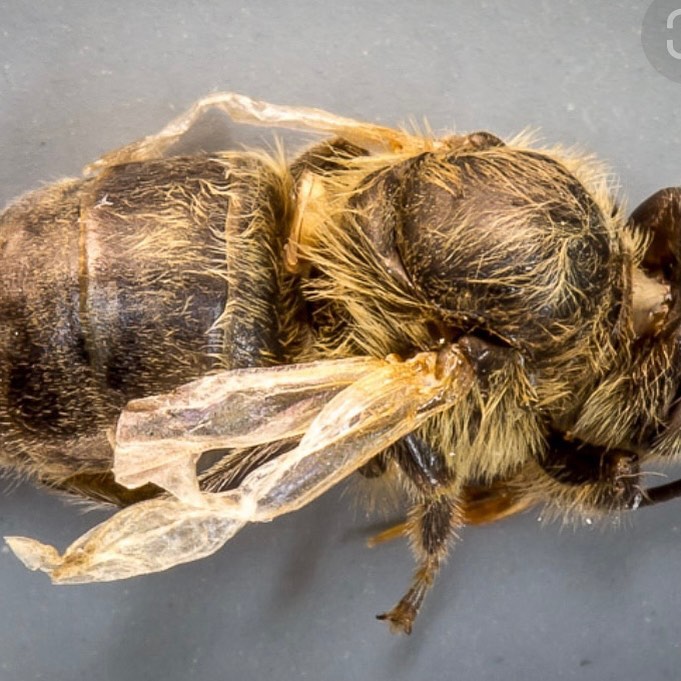Ваша моцарелла не тянется или горит? Секрет в науке. От процесса «паста филата» до решающей роли созревания...
Вирус деформированного крыла (DWV): Глобальный кризис медоносных пчел с точки зрения вирусологии и патологии пчел

В последние годы распространение смертоносного штамма вируса деформированного крыла (Deformed Wing Virus - DWV) быстро превращается в глобальный кризис для медоносных пчел (Apis mellifera). Этот вирус, передаваемый паразитическим клещом Varroa destructor, не только вызывает аномалии крыльев и быструю смерть отдельных пчел, но и приводит к полному коллапсу целых колоний. С точки зрения вирусолога и патолога пчел, это явление — не просто инфекционное заболевание, а извращенный эволюционный симбиоз между паразитом, вирусом и восприимчивым хозяином, который меняет динамику экосистем опыления по всему миру.
В этой статье, основываясь на последних научных данных, мы проведем всесторонний анализ механизмов передачи, генетических изменений вируса, его системного воздействия на пчел, а также рассмотрим новые стратегии контроля и управления колониями, находящимися под угрозой.
Введение: DWV — не вирус, а патогенный комплекс
С клинической точки зрения, вирус деформированного крыла (DWV) является патогенным РНК-вирусом из семейства Iflaviridae, который естественным образом существовал на низком уровне в популяциях медоносных пчел. Однако с появлением клеща Varroa destructor в качестве биологического переносчика, экологический баланс этого вируса был нарушен, превратив его в основной фактор синдрома коллапса колоний (Colony Collapse Disorder - CCD).
Ключевой момент: DWV без Varroa — низкорисковый. Varroa без DWV — управляем. Но их комбинация — катастрофа.
Основные штаммы DWV и последние генетические изменения
Были выявлены три основных штамма DWV:
- DWV-A: Исходный, менее вирулентный штамм, распространенный в 1980-х годах.
- DWV-B: Новый, высокопатогенный штамм, распространившийся с начала 2000-х годов.
- VDV-1: Родственный вирус, часто встречающийся в сочетании с DWV.
| Характеристика | DWV-A | DWV-B | VDV-1 |
|---|---|---|---|
| Скорость размножения в клеще Varroa | Средняя | Очень высокая | Высокая |
| Вирулентность (смертность) | ~60% | ~90% | ~70% |
| Глобальное распространение | Региональное | Глобальное (кроме Австралии) | Широкое |
| Влияние на нервную систему | Среднее | Сильное | Среднее |
Недавние геномные анализы (2023) показывают, что DWV-B по сравнению с DWV-A обладает более высокой стабильностью в окружающей среде, более быстрой скоростью размножения в теле клеща и большей способностью уклоняться от врожденного иммунного ответа пчелы. Этот вирус даже способен подавлять систему РНК-сайленсинга (RNAi) пчелы.
Механизм передачи: Как Varroa действует как "вирусный шприц"?
Клещ Varroa destructor — это не просто паразит, а активный биологический переносчик, играющий ключевую роль в эволюции вируса.
1. Вертикальная передача (от клеща к пчеле)
Во время питания тканями пчелы клещ впрыскивает вирус непосредственно в ее кровеносную систему (гемолимфу). Этот метод передачи гораздо более эффективен, чем горизонтальная передача (физический контакт).
2. Размножение вируса в теле клеща
Вирус размножается в тканях клеща, и вирусная нагрузка в клеще достигает очень высоких уровней. Это превращает каждого клеща в "фабрику по производству вируса".
3. Естественный отбор патогенных штаммов
Клещи косвенно отбирают те штаммы вируса, которые лучше размножаются в их телах — а это, как правило, те же самые штаммы, которые более смертоносны для пчел.
Клинические и патологические эффекты у пчел
Хотя самым очевидным симптомом являются маленькие, сморщенные и аномальные крылья, повреждения, наносимые вирусом, начинаются изнутри:
- Повреждение нервной системы: Вирус поражает мозг и центральную нервную систему пчелы, вызывая дезориентацию, нарушение обучения и неспособность вернуться в улей.
- Сокращение продолжительности жизни: Зараженные пчелы живут не более 48 часов после появления симптомов.
- Физическая слабость: Маленькое, округлое брюшко, парализованные ноги и неспособность летать.
- Репродуктивные проблемы: Зараженные матки производят неоплодотворенные яйца, и здоровье трутней также страдает.
- Ослабление иммунной системы: Зараженные пчелы гораздо более восприимчивы к другим патогенам (таким как бактерии и грибки).

Глобальное распространение и эпидемиологические изменения (2020–2024)
Анализы, проведенные международной командой из Университета MLU и Глобальной инициативы по здоровью пчел (Global Bee Health Initiative) на основе более 5000 генетических наборов данных образцов медоносных пчел и клещей Varroa из баз данных NCBI и Bumblebee Conservation Trust, показывают:
- Европа: С 2015 года DWV-B стал доминирующим штаммом (более 85%).
- Северная Америка: Распространенность DWV-B выросла с 30% в 2018 году до более чем 70% в 2023 году.
- Азия: Выявлен в 2015 году и быстро распространяется в Китае, Индии и Иране. В некоторых регионах сообщалось о гибридных штаммах DWV-A/B.
- Австралия: Пока нет официальных сообщений о DWV-B — вероятно, из-за строгого контроля за ввозом клеща Varroa и сильной биологической политики.
- Дикие пчелы: DWV-B был обнаружен в образцах шмелей (Bombus spp.) и пчел-осмий (Osmia spp.), что указывает на межвидовую передачу и более широкую угрозу биоразнообразию.
Современные стратегии управления колониями: От РНК-вакцин до устойчивых пчел
На основе рекомендаций исследовательской группы MLU, Всемирной организации по охране здоровья животных (WOAH) и Международной ассоциации пчеловодства (IAB), следующие стратегии необходимы для контроля и предотвращения распространения вируса:
- Гигиена ульев и зимнее управление: Регулярная очистка ульев, замена старых рамок и снижение плотности колоний в зимний период.
- Биологический и генетический контроль: Использование пчел, устойчивых к клещу Varroa (например, штаммов Varroa Sensitive Hygiene - VSH или Suppressed Mite Reproduction - SMR).
- Умный химический контроль: Использование одобренных препаратов, таких как щавелевая кислота, флувалинат или тимол, в подходящее время и с ротацией для предотвращения резистентности.
- Перспективная вакцинация: Ведутся исследования по разработке вакцин на основе РНК-интерференции (RNAi), которые позволят пчелам распознавать вирус и предотвращать его размножение.
- Сохранение растительного разнообразия: Посадка пыльценосных и нектароносных растений для укрепления иммунной системы пчел.
- Регулярный мониторинг и генетическое тестирование: Использование количественной ПЦР для отслеживания вирусной нагрузки в ульях и принятия своевременных решений о лечении.
Поддержите своих пчел — покупайте наш натуральный мед!
Каждая купленная у нас банка меда напрямую помогает поддержать местных пчеловодов, размножать устойчивых к Varroa пчел и защищать биоразнообразие.
- 100% натуральный и чистый мед
- Соответствие санитарным нормам
- Сертификат качества и прозрачное происхождение
- Свето- и влагонепроницаемая упаковка
Специальное предложение: При покупке сегодня — скидка 20% + бесплатная доставка по всей стране!

Слово специалиста: Пчелы просто нуждаются в нас
Как специалист по болезням пчел, мы подчеркиваем, что кризис DWV — это не только проблема пчеловодства, это болезнь экосистемы. Мы являемся свидетелями эволюционного сдвига, в котором вирус, при помощи паразита, получает доминирование над ключевым видом в нашей экосистеме.
Как подчеркивал профессор Роберт Пакстон: «Никто больше не заботится о них.» Мы, как пчеловоды, потребители и граждане планеты, несем ответственность за защиту этих жизненно важных существ с помощью разумных действий. Это возможно только благодаря образованию, мониторингу и финансовой поддержке местных пчеловодов.
Научные источники и ссылки
- Wilfert, L., et al. (2016). Deformed Wing Virus is a recent global epidemic in honeybee populations. Science, 351(6274), 594–597. https://doi.org/10.1126/science.aad2608
- Locke, S. J., & Moro, G. L. (2023). Varroa destructor: Global spread, impacts, and solutions. Annual Review of Entomology, 68, 123–142. https://doi.org/10.1146/annurev-ento-110421-024747
- Genersch, E. (2010). Honey bee pathology: current threats to honey bees and beekeeping. Applied Microbiology and Biotechnology, 87(1), 87–97. https://doi.org/10.1007/s00253-010-2528-2
- McMahon, D. P., et al. (2022). The role of deformed wing virus in the global decline of honey bees. Nature Reviews Microbiology, 20(3), 153–165. https://doi.org/10.1038/s41579-021-00632-7
- Global Bee Health Initiative. (2023). Annual Report on Honey Bee Viral Surveillance. https://globalbeehealth.org/reports/2023
- Bumblebee Conservation Trust. (2022). Wild Bee Virus Monitoring Program. https://www.bumblebee.org














Последние комментарии